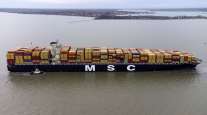Growth of Web-Based Sales Lifts Start of Holiday Season

This story appears in the Dec. 7 print edition of Transport Topics.
The early holiday shipping season featured more online purchases, which could help to ensure smooth package delivery flow, experts said.
Research firm ShopperTrak calculated retailers’ in-store sales fell 10% to $20.4 billion on Nov. 27, the day after Thanksgiving known as Black Friday.
But on Cyber Monday, which was the next business day, Nov. 30, online sales rose 6% to $3 billion, according to Adobe Systems Inc.
One sign that shipping patterns will be spread out was the 26% rise in online transactions for the Nov. 28-29 weekend, and an 18% rise on Cyber Monday, according to International Business Machines Corp.
“Our data shows that business-to-consumer shipments are growing at a rapid rate and that the peak is getting spread out,” said Satish Jindel, president of Shipmatrix, an analytics service for shippers, citing Amazon.com Inc.’s ability to ship 5.5 million packages in a day.
Spreading out deliveries “in many ways is good for the less-than-truckload and parcel guys.” A smoother package flow helps to control labor assignments and operations, said Jindel, who also heads SJ Consulting. Labor is the largest cost for UPS Inc. and FedEx Corp.’s Ground units.
“The theme for this holiday is that promotions started earlier,” Oliver Chen, retail analyst at Cowen and Co., told Transport Topics. “Sales are more spread out.”
Retailers are focused on offering more convenience to customers, he said, such as free shipping and returns as well as continuing to speed up deliveries.
One factor in speeding deliveries is the move by brick-and-mortar retailers and virtual retailer Amazon to locate distribution centers closer to customers to also improve reliability, both analysts said.
But by building more distribution centers that shorten delivery distances to customers, Jindel said, Amazon directs at least 70% of its packages directly to the U.S. Postal Service for last-mile home deliveries, an increase over past years.
That’s hurting UPS, FedEx and smaller delivery services this year, he said, as those companies are moving products that aren’t stocked at the distribution center closest to the customer, he said.
As a result of that shift, Jindel believes that FedEx and UPS won’t move as many packages this year as they have predicted, repeating the pattern of recent years. For example, he said FedEx last year forecast 8.8% holiday shipment growth but achieved 5.8%.
“Our volume is up considerably,” said Sarah Ninivaggi, spokeswoman for the Postal Service, adding that a 10.5% rise in package shipments between Thanksgiving and New Year’s Eve is expected.
UPS, FedEx and Amazon didn’t comment on Jindel’s analysis, or service quality.
Dan McMackin said UPS doesn’t disclose “snapshots of volume” because it could be misleading or misinterpreted. UPS’ holiday performance will be disclosed Feb. 2 with earnings.
FedEx spokeswoman Rae Rushing said Cyber Monday and the first two Mondays in December would have more than double the average daily package volume. FedEx could provide holiday shipping details in a Dec. 16 earnings announcement.
On a positive note, kickoff of the shopping season didn’t feature any significant weather delays. Between Thanksgiving and Dec. 3, the only reported weather delays were in parts of central Nebraska and southern South Dakota.
In past years, snow and ice storms hamstrung delivery plans through major package hubs. Weather woes contributed to delivery difficulties for UPS in 2013.
Changing gift-buying habits also affect shipping. IBM noted buying patterns have shifted toward smaller, lighter electronics and technology products such as video games, and fewer purchases of more bulky apparel.
Jindel said warm weather in recent weeks also depressed clothing purchases, and Chen noted a shift away from traditional gifts such as watches and handbags.
While the four-day surge gets wide attention, it’s just a piece of the buying picture.
“The success of the holiday season doesn’t hinge on the performance of a single day,” ShopperTrak founder Bill Martin said. “Seven out of the top 10 sales days still remain, and December is anticipated to be strong.”
ShopperTrak forecasts 2.4% total holiday season growth, below the 3.7% growth forecast by the National Retail Federation.
Chen estimates 2% to 3% sales growth, citing a shortage of new products, warmer weather and fewer tourist shoppers because of the strong dollar.
Jindel also noted Amazon’s experiments “to take more control over the delivery process.” That includes its own delivery vehicles, drone experiments and even an air shipping network. And he said there’s an additional reason:
“They are testing these models as a way to send a message to the Post Office, FedEx and UPS that if your prices are too high, I will move packages myself.”
UPS and FedEx rank Nos. 1 and 2, respectively, on the Transport Topics Top 100 list of the largest U.S. and Canadian for-hire carriers.




